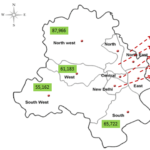Sustainable use of Resources for Renewable Energy Production
Today, the world is facing many predicaments like an unremitting increase in population ( nearly 8 billion). Most of this population growth will be in Asia and Africa where rapidly rising economic growth will thrust additional demand on energy supply. The International Energy Agency (IEA) based in Paris has projected that the World’s energy demand will increase from about 12 billion tone oil equivalents (t.o.e.) in 2009 to either 18 billion t.o.e. or 17 billion t.o.e. in 2035.
Simultaneously, this ever-growing energy needs and depleting fossil fuel resources demand sustainable (which are clean, affordable, reliable, and accessible) alternatives as well as renewable energy resources. Cellulosic biomass production is directly linked with land resources. If higher cellulosic land mass production occurs in a particular land area then that means the soil fertility and health in a particular area are better for the survival of more biodiversity. Cellulosic biomass, the most abundant resource, is used to produce bioenergy, one of the most significant alternative renewable and sustainable energy resources. Production of biofuels from plant-derived biomass such as agriculture and forestry residues could serve the dual role of renewable energy production and waste reduction according to a statistical review of world energy, a six-fold increase was observed in biofuel production within a decade from 2002 to 2012. Around 60.2 million t.o.e of biofuels were produced all over the world. 90% of the worldwide biofuel is produced in North America, South America, Europe, and Eurasia. India produces only around 2.94 lakh t.o.e. biofuel production which is a mere 0.5% of total biofuel production. Therefore, there are a lot of scopes to use sustainable natural resources to enhance sustainable biofuel production.

ALL CONTACTS
- A-148, 2nd Floor, Gujranwala Town, Delhi - 110009
- +91 98188 91223
- donations@kib.org.in
SUBSCRIBE
Never miss out on any news and updates by Keep India Beautiful.
- Keep India Beautiful. Copyright 2024








